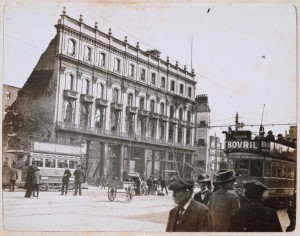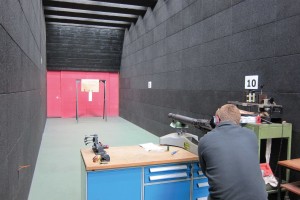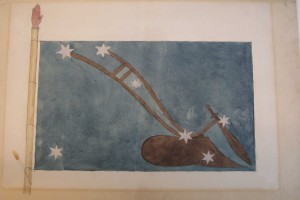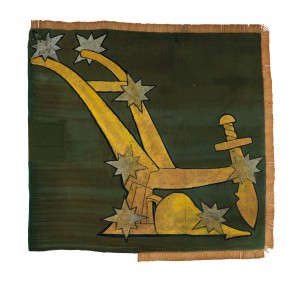The Citizen Army’s ‘Starry Plough’ flag
Published in 1913, Decade of Centenaries, Features, Issue 6 (November/December 2014), Volume 22The Starry Plough flag has been in the possession of the National Museum (NMI) since 1956 and has recently been conserved in commemoration of the centenaries of the foundation of the Labour Party (1912), the Dublin Lockout (1913) and the Easter Rising (1916). Funding was provided by individual contributions from members of the Labour Party.
When I was entrusted with the conservation of the flag, the importance of the Starry Plough as a cultural icon of the foundation of the state led me to examine its historical context and discover what could be learned from its present state. Extensive investigation was carried out into the history, construction and nature of the damage to the flag. As well as researching the historical record, scientific analysis not possible in the 1950s was undertaken. This involved collaboration with expert conservators from different disciplines in the national cultural institutions, as well as the state laboratories, the Garda Síochána and the Irish Defence Forces.
On first examination, the flag consisted of three lengths of green fabric, machine-stitched together, with yellow fringing. The design is graphic and painted on both faces with yellow, dark blue and silver paint. Prior to the commencement of work, the flag was mounted back to front on an old mount board that was too small for the object. Sections of cotton tape had been stuck to one side and a series of patches inserted. The flag was crumpled and distorted, partially from the mount but also owing to the weight of the paint pulling against the silk. There were over 50 small holes peppered throughout the piece. On removal from the board, the full extent of the light damage, soiling and extensive structural weakness, especially on the top third, became apparent.
Is it the right flag?

Before conservation—the flag had been mounted back to front on an old mount board that was too small for the object. (Rachel Phelan)

The shell of the Imperial Hotel on 16 May 1916, after the Rising, with the empty flagpole to the right of the building clearly visible. (RIA)
On being offered a green flag, G.A. Hayes-McCoy, then curator of military history in the NMI, immediately wrote to the playwright Seán O’Casey. O’Casey had been secretary of the Citizen Army for a short period in 1914–15 and had written a history of the ICA in 1919. Most famously, his celebrated play The Plough and the Stars (1926) had depicted the flag ‘falling like a shot as the roof crashed in’ and going up in flames. O’Casey replied that the flag could not be original and submitted a watercolour as evidence, saying that it was the original design by William Megahy. This image matches his earlier description of the Starry Plough as ‘a rich deep poplin field of blue . . . with the formalised shape of a plough, a gold-brown colour, while through all glittered the gorgeous group of stars’. Not only the background colour, however, but also the rectangular shape and the design of the plough and the stars are all different from the NMI flag.
T.A Williams, a British Army officer who had kept the flag as a trophy, countered with this cutting from the Irish Times of 11 May 1916:
‘The rebels, on taking possession of the Imperial Hotel in Sackville Street, hoisted their flag over the building, and there it remained intact on one of the ridges of the front wall while the entire contents of the premises were being consumed by fire. At great personal risk the flag was eventually brought down by second Lieutenant T.A. Williams of the 9th Reserve Cavalry, Kildare Barracks, assisted by Inspector Barrett, Dublin Metropolitan Police.’
Photographs of the Imperial Hotel building taken on 16 May 1916 clearly show an empty flagpole at the Liffey end of the ruined building. In the famous April 1914 photograph of the Citizen Army at Croydon Park, the man on the far left is holding something that looks very like the flag; segments of stars and the plough are just visible. The stars are clearer still in a 1915 image of the ICA at O’Donovan Rossa’s funeral. Unfortunately these photos are in black and white and give no indication of colour.
Hayes-McCoy tracked down as many old ICA men as possible and invited them to view the flag. Their reaction was one of confusion, commenting on how old and dirty it looked: ‘Our flag was beautiful, with silver stars and a gold fringe’. Its authenticity was not questioned, however, and on the basis of his enquiries the state acquired the flag for £150.
The Hayes-McCoy investigation was confined to members of the ICA. It was their flag after all. However, I also discovered this reference from Irish Volunteer Joe Sweeney, station-ed at the GPO. He recalled:
‘Friday dawned on a desolate site opposite us. All that remained of Clery’s and the Imperial Hotel was the front wall of the building on the top of which to Connolly’s great delight the flag of the Citizen Army still floated proudly.’
Whether it was blue or green, something survived the fire.
Technical and material analysis

Detective Garda David O’Leary at the Phoenix Park range firing a Lewis machine-gun at a similar piece of fabric. Subsequent photomicrograph comparisons of the sample bullet damage to the holes in the flag revealed multiple similarities. (Rachel Phelan)
To analyse the paint, Ele Von Monschaw, a paintings conservator from the National Gallery of Ireland (NGI), came to take samples for the state laboratories. Her visual assessment was that both the yellow and the white paint had a high lead content (subsequently confirmed by analysis). She noted that it was very dirty for a ‘modern’ object. The piece had been on open display for many years, but apart from surface dirt there was also substantial ingrained discoloration of the paint, and this chemical reaction to pollutants normally takes several centuries. When it was explained that the flag had flown over a building that was destroyed by fire, Von Monschaw replied, ‘Oh, that‘ll do it!’ The massive release of pollutants combined with the heat of the flames had accelerated the reaction.
Subsequent X-ray analysis of the flag clearly shows the yellow and white sections, indicating the high metal content of these paints. On close examination, small fluorescent metal particles are visible on the fringe. The Citizen Army men were right: the fringe was once golden. We decided to preserve the ingrained soiling as historically important and only clean the painted areas with softened water. The flag was then humidified to remove crumpling and distortions.
Old museum images of the flag were tracked down to determine when the patches were applied. As the patches were clearly of a later date than acquisition, they were carefully removed using solvents. A silk crepeline overlay was dyed to match the flag and an adhesive overlay cast onto it. The large damaged section at the top of the flag was pinned out and realigned before the overlay was applied.
Bullet holes

When the green flag surfaced in 1956, Seán O’Casey claimed that it could not be original and submitted this watercolour as evidence, saying that it was the original design by William Megahy. (NMI)
Finally, a large fabric-covered board was made to display the flag. Dyed cotton patches to infill areas of loss were stitched to the board, not to the flag. The flag was then separately stitched to the board. Each piece of the fringe was individually stitched down, but the original errors in manufacture remain visible.
To date, every investigation would indicate that this is the flag of the Irish Citizen Army that flew over the Imperial Hotel at Easter 1916. At some point a decision was made to alter Megahy’s original design, and in 1916 the Citizen Army marched behind a flag of green, white and gold. The conserved flag has been on display at Collins Barracks from September 2013 as part of the National Museum’s exhibition to commemorate the Dublin Lockout.
Rachel Phelan is a textile conservator and art historian.
Read More:A brief history
Further reading
R.M. Fox, The history of the Irish Citizen Army (Dublin, 1943).
G.A. Hayes-McCoy, A history of Irish flags from earliest times (Dublin, 1979).
S. O’Casey, The story of the Irish Citizen Army (Dublin, 1919).

















